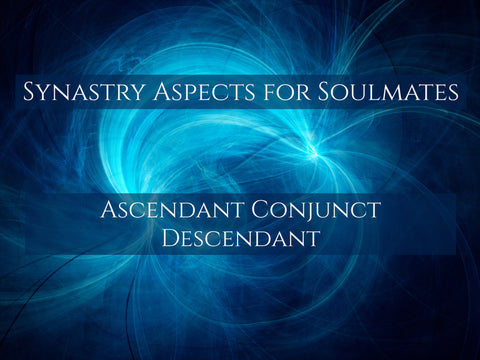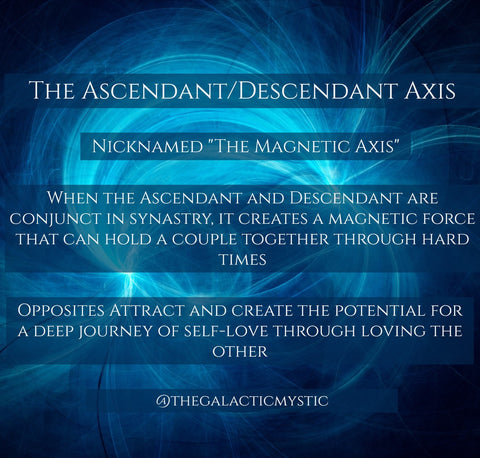Synastry Aspects for Soulmates - Ascendant Conjunct Descendant

Synastry Aspects for Soulmates - Ascendant Conjunct Descendant
The ascendant/descendant axis and what it means in our relationship synastry when we have this axis conjunct, let’s talk about it!
As always I have my two little disclaimers. The first is even though this series is called “synastry aspects for soulmates,” I want you to use whatever word you use for those deeply impactful relationships that just get you in the guts. These relationships can be very short-lived or they can be long-term. I'm not talking about duration, I'm talking about those relationships that really leave their mark on your life.
My other disclaimer is about synastry aspects in general. Today I'm talking about angles or axes and these axis conjunctions carry a lot of weight in synastry, but they’re still not everything. You have to look at your synastry as a whole. Relationships need to be looked at with a wider lens astrologically, because each and every aspect creates a nuance to the energy. It would not be accurate or appropriate to reduce the interpretation down to one aspect. Truly, the astrology of your relationship is as multifaceted and complex as you each are as individuals.
The ascendant descendant axis is sometimes nicknamed the magnetic axis. The ascendant, sometimes shortened to “AC,” is also called your rising sign which may be more familiar. Your ascendant is the sign and exact degree of whatever zodiac sign was on the eastern horizon at the moment and location of your birth. It marks the cusp of your first house and it is a huge aspect of your personality and how people see you. It is the mask you wear when you are in unfamiliar territory.
The ascendant is often people’s first impression. It's like the suit you climb into to show the world who you are. It represents the qualities that we WANT the world to see in us. It doesn't mean that we aren't these things, but it speaks to how we choose to showcase ourselves. It speaks of how we behave and which parts of ourselves we put forth when we are in unfamiliar territory. As the cusp of the first house it also represents what we look like and our physical bodies.
Personal example, Sagittarius 0° is my ascendant. Sagittarians are generally very social, optimistic, and adventurous. At 0° and with Jupiter as the ruler of Sagittarius, there is an unavoidable “bigness” to this energy. People who know me would say this is a very accurate description of me: my voice is loud, I laugh easily, my body is big in presence, etc. I am all of these things but I'm also a major introvert and am much more comfortable with my own company. When people who have known me for a very long time hear me say that I'm an introvert they look at me like I’m lying to them. This is because they’re most familiar with my social mask that has them believing that I am a life-of-the-party extrovert.
The descendant, shortened to “DC” marks the cusp of the seventh house of marriage and partnerships, one-on-one relationships, and other things like open enemies. It’s about “the other.” Simplified, it represents your partner and that is significant, but you can also think of the descendant as the parts of you that you don't want the world to see. These are the parts of ourselves that we struggle to accept and struggle to love, but we love in others. Isn't that kind of perfect when it comes to relationships. This brings in the concept of conscious partnering and how incredibly powerful our relationships are as spiritual classrooms.
This is part of what is so beautiful about the ascendant/descendant conjunction in synastry, because when we see our partner embodying these qualities that we reject in ourselves and we love them in our partner, we are inadvertently learning to love and accept these qualities in ourselves.

This conjunction is like glue. Magnetic opposites undeniably attract.
In this video I show synastry chart examples of this AC/DC conjunction.
The orb of conjunction I use is 6 degrees, but it’s strongest when the orb is within two or three degrees. With conjunctions or with anything conjunct an axis, I use up to six degrees most of the time.
If there are other axes or personal planets also conjunct the ascendant/descendant axis conjunction, even better.
This ascendant descendant conjunction alone does a very interesting thing in the chart. It creates a synastry energy where all the houses for the whole chart are conjunct to their opposite house in the partner’s chart. This really highlights this magnetic quality to this conjunction and creates a situation where each individual holds the balance that the other needs in EVERY astrological energy represented in the houses. This brings these people and locks them in place and gives them a sort of… extra ability to overcome the challenges that come with marriage. This doesn't mean that their struggles are less difficult than other people have in their relationships, it just seems to give them an extra reserve tank of energy for each other. Think of how difficult it is to pull 2 magnets apart once they’ve locked in. It’s harder to pull them apart, but create friction between them and they will separate.
Marriage and partnering are never 100% problem-free, but this axis conjunction will give a couple extra juice to push through those very difficult times. Often these couples stay together for a very long time.
The couple whose chart I use in the video for this aspect got married within 6 months of meeting. They've now been married for over 25 years and have made it through MANY years-long “rough patches.” I recently worked with a couple who have this synastry conjunction who had been married for 33 years and finally decided to call it quits. They both expressed how exhausted they were with the years of trying to make it work, emphasizing how hard they tried. Again, we see the metaphor of how enough steady friction can break the bond, even after decades together.
Other synastry and relationship astrology articles:
Vertex Conjunct Anti-Vertex/Vertex Conjunct Vertex
For relationship astrology and synastry readings go here.
Very helpful article! Thank you! I just found out my best friend of a long time and I have conjunct Asc/Desc on the same degree! With Pluto there close by, and North and South Nodes. I have always felt he understands what I fail to understand and vise-versa! Also both of our chart rulers are conjunct in both our charts, in the same sign (as we were born only a few days apart). It has been wild discovering this about our charts. And now it makes sense why the level of familiarity was high even in the beginning of our friendship. And why we seem to understand each other, even in our pronounced differences. Oh, opposite moons, too. 😅
Help
Thank you for this break down amd better understanding. My question is my boyfriend is a taurus rising cusp he is on the cusp of gemini. We are both asc opppsit dependent but the rest of the houses aren’t opposites because he’s on the cusp his birthfay is 0ct 31st 1981 my question is will we still have that magnetic pull as you stated above even though our risings signs are the only thing that is opposit in the houses.
I share this aspect with my son
I have stumbled across your video and info trying to find answers. This man and my natal chart-ours is even closer. I am happy to provide you the data for review, if you will help me understand more. I have 3 yods in my chart alone. I have known since the second I met him. I’ve known him before. I’ve never seen a chart similar to ours so I’m so happy we are not alone. I’m also happy to hear that these people make it.